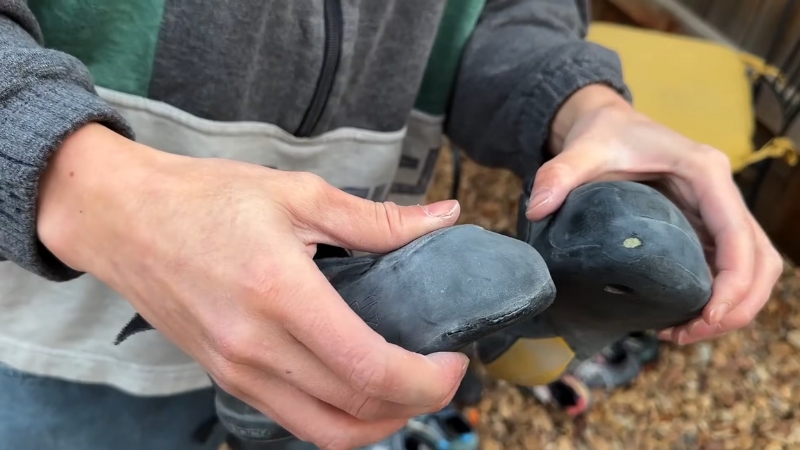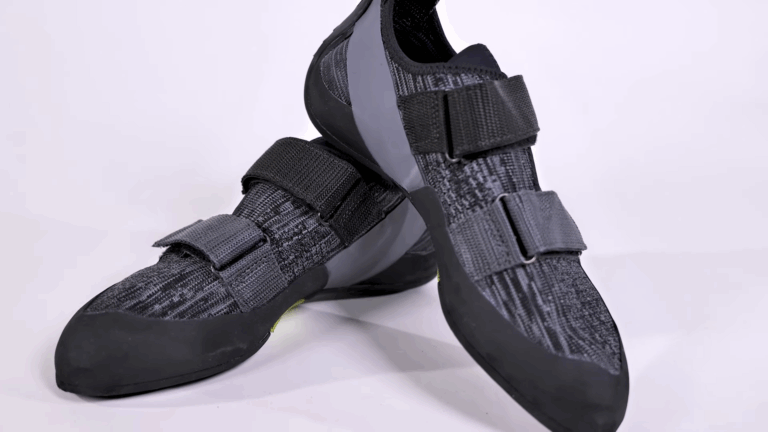You know the feeling. You finally found that perfect pair of bouldering shoes—the ones that stick on tiny edges, smear confidently, and feel like an extension of your foot. But after a few months of climbing, they’re starting to look and smell… less than fresh.
The rubber is wearing thin, they’re losing their shape, and the odor is downright embarrassing.
Caring for your bouldering shoes is essential if you want to keep climbing at your best and avoid dropping cash on new pairs every few months. It’s not just about keeping them clean; it’s about maintaining grip, shape, and comfort while preventing stink and breakdown.
Air Them Out After Every Session

Climbing shoes are like sweat sponges. Unlike your running shoes, which at least get a bit of airflow during use, bouldering shoes trap moisture directly against your skin with no socks to absorb it.
After a long session, especially in a warm gym or sunny crag, your shoes are damp and warm inside, creating the perfect environment for bacteria and mold to grow. This bacterial buildup not only leads to the infamous climbing shoe stench but also can break down the lining materials over time.
The trapped moisture can make the inside slippery, affecting how securely your foot sits in the shoe. To avoid this, make it a habit to remove your shoes from your pack immediately after climbing. Place them in a shaded, ventilated space where air can circulate freely.
Avoid stuffing them in closets or leaving them zipped up in your bag overnight. If you’re commuting, clip them to the outside of your pack with a carabiner to let them breathe, but keep them inside a mesh bag on public transport to be considerate of others. The goal is simple: dry them out as soon as possible, every time.
Keep Them Out of the Sun and Heat
You might think that leaving your shoes outside in the sun is a good way to dry them fast. But direct sunlight and high heat can destroy climbing shoes more quickly than almost anything else.
The adhesives used to bond the rubber to the upper are heat-sensitive and will start to weaken at high temperatures, causing the rubber to peel or crack. This isn’t just about aesthetics; delamination of the sole can completely ruin a shoe’s performance, leaving it unusable for climbing.
Additionally, excessive heat can cause the rubber itself to harden and lose its stickiness, which is crucial for smearing and edging. Even the synthetic or leather materials of the upper can shrink or warp in the heat, altering the fit you worked so hard to break in.
Always dry your shoes in a shaded, cool place. If they do get wet during climbing, let them dry naturally in the open air, away from any direct heat source. Never use heaters, dryers, or leave them baking in a hot car. These simple precautions will save your shoes from premature aging and structural failure.
Focus on Footwork
View this post on Instagram
Footwork isn’t just about sending harder climbs—it’s directly linked to how long your shoes last. When climbers drag their toes up the wall, smear carelessly, or scrape across holds, they grind away at the rubber. This is especially obvious on overhanging routes or textured outdoor rock where precision is key.
Black smudges on the wall aren’t just cosmetic; they’re tiny bits of your expensive rubber being left behind. To extend the life of your shoes, practice precise, intentional foot placements.
Instead of blindly jamming your foot onto a hold, pause and look at the target area. Visualize where you want to place your toe, and then set it down cleanly.
On familiar climbs, focus on repeating the route with smoother, more controlled movements. Outdoor climbers should carry a brush to clean holds before use, reducing the risk of sand and grit eroding the rubber.
The more mindful you are about how your feet interact with the wall, the less unnecessary wear you’ll put on your shoes—and the better your climbing will become.
Don’t Walk Around In Them
The rubber on climbing shoes is engineered for optimal grip on rock and plastic holds, not for hard floors, gravel paths, or gym mats. When you walk around in your shoes between climbs—especially outdoors—you grind dirt, sand, and small stones into the soles.
These abrasive materials wear down the sticky rubber and compromise grip. Over time, this not only reduces performance but also increases the likelihood of needing a rescue.
To prevent this, always carry a pair of easy-on shoes like flip-flops or approach shoes for walking between climbs. If you must move a short distance in your climbing shoes, walk carefully on your heels to protect the toe area and minimize contact with the ground.
Before you start a climb, always wipe the soles clean with a towel, your pants, or even your hands to remove any debris. A simple routine like this adds months to the lifespan of your shoes and keeps them performing at their best.
Keep the Soles Clean for Better Grip
Your shoes’ performance depends on the cleanliness of the rubber. Dirt, chalk, and mud reduce friction, making footholds feel slippery and unreliable. During a session, it’s easy for grime to accumulate unnoticed, especially at outdoor crags where dust and sand are everywhere.
Make it a habit to clean your shoes regularly during and after climbing. Many bouldering pads come with a built-in carpet square specifically for this purpose.
Before stepping on the wall, give the soles a quick rub on the carpet or a dedicated towel. If dirt is stubborn, use a soft toothbrush to gently scrub the rubber with a damp cloth. Focus only on the rubber and avoid soaking the shoe’s upper to prevent damage to the structure and glue.
Once cleaned, dry the shoes thoroughly with a towel or let them air dry in a shaded, ventilated area. Keeping your soles clean isn’t just about looking good—it’s about maintaining that crucial stickiness that can make or break a send.
Tackle Odors Early
A strong odor isn’t just unpleasant—it’s a sign of bacteria buildup inside your shoes, which can degrade materials and make them less comfortable. Instead of waiting for the smell to become unbearable, tackle it proactively.
Use shoe deodorizers designed specifically for climbing shoes, like Boot Bananas or antibacterial sprays, which target both odor-causing bacteria and moisture. For a DIY option, sprinkle a small amount of bicarbonate of soda (baking soda) inside each shoe, shake it to distribute evenly, and leave it overnight.
Be sure to vacuum or shake out the powder before use, as leaving it in can mix with sweat to form an unpleasant paste. Consider wearing thin, seamless socks during sessions to absorb moisture and reduce bacteria transfer from skin to shoe lining.
Socks may slightly reduce sensitivity, but they can extend the lifespan of your shoes and keep your bag from smelling like a swamp.
Clean Shoes Occasionally (But Carefully)
@adventuressinthewild Here is the best way to clean your climbing shoes knowing that it won’t ruin the glue or material. Clean shoes solve problems! #girlswhoclimb #womenwhoclimb #adventuressinthewild #climbing #climbinglife #bouldering #climbingtips #shoechalk #climbingshoes #boulderingtips ♬ FEEL THE GROOVE – Queens Road, Fabian Graetz
Regular cleaning removes the buildup of salts, oils, and grime that can weaken the shoe’s structure and make the fit slippery. However, washing requires care. Start by soaking synthetic shoes in warm (not hot) water for up to an hour to loosen grime—skip this for leather or high-performance shoes.
Gently scrub inside and out using a soft toothbrush with mild soap or just water. Avoid harsh chemicals or high temperatures, as they can damage adhesives and materials.
Rinse thoroughly with cool water, then dry naturally in the shade. Never machine wash leather or hybrid shoes, and avoid any heat sources for drying.
If your shoes are particularly smelly, combine a cleaning routine with deodorizing methods to tackle both the dirt and the odor.
Consider a Shoe Rotation
Rotating between multiple pairs of climbing shoes isn’t just for the pros—it’s a smart strategy to extend the life of every pair. Each shoe gets time to air out and recover its shape between sessions, reducing moisture buildup and material fatigue.
A common rotation might include one tight, precise pair for hard sends, a slightly looser pair for training and warm-ups, and an older pair for outdoor approaches or dirtier climbs. By spreading out the wear and tear, you reduce the chance of rapid degradation and get more consistent performance from all your shoes.
Bottom Line

Your climbing shoes are your most important tools on the wall. Treat them right, and they’ll stick with you through thousands of moves, smears, and sends. Let them get sloppy, and you’ll be slipping and replacing them sooner than you’d like.
If you’re still choosing your first or next pair, the top 10 bouldering shoes list is a good place to start.
Clean them, air them, store them smart, and they’ll reward you with performance and longevity. Think of it like taking care of your car—regular maintenance beats costly repairs. Show your shoes some love, and they’ll keep you climbing strong.

